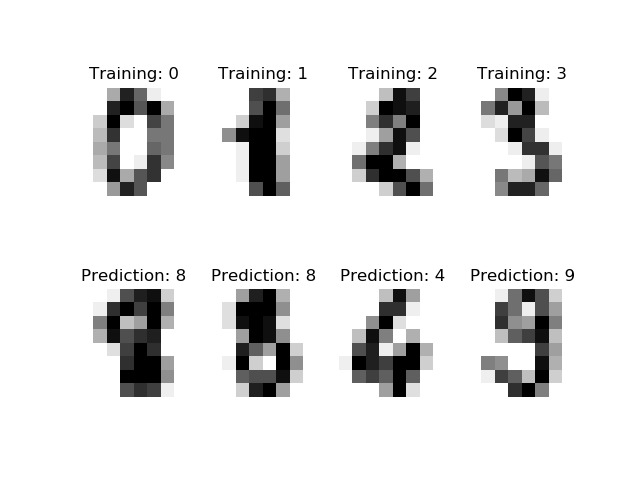示例简介
一个代码示例,显示如何使用scikit-learn识别图像中的手写数字。
该示例的更详细介绍参考用户手册的教程部分。
代码实现[Python]
# -*- coding: utf-8 -*-
print(__doc__)
# Author: Gael Varoquaux
# License: BSD 3 clause
# 导入绘图包matplotlib
import matplotlib.pyplot as plt
# 导入数据集、分类器及性能评估器
from sklearn import datasets, svm, metrics
# The digits dataset
digits = datasets.load_digits()
# 我们感兴趣的数据是由8x8的数字图像组成的,让我们
# 看一下存储在数据集的"images"属性中的前4张图像。处
# 理图像文件,则可以使用matplotlib.pyplot.imread加载它们。
# 请注意,每个图像必须具有相同的大小。对于这些图像,我们知道它们代表哪个数字:它在数据集的“target”中给出。
images_and_labels = list(zip(digits.images, digits.target))
for index, (image, label) in enumerate(images_and_labels[:4]):
plt.subplot(2, 4, index + 1)
plt.axis('off')
plt.imshow(image, cmap=plt.cm.gray_r, interpolation='nearest')
plt.title('Training: %i' % label)
# 要对该数据应用分类器,我们需要将图像展平,以将数据转换为(样本,特征)矩阵:
n_samples = len(digits.images)
data = digits.images.reshape((n_samples, -1))
# 创建分类器: 一个支持向量机分类器
classifier = svm.SVC(gamma=0.001)
# 我们使用数据集的前半部分学习数字识别模型
classifier.fit(data[:n_samples // 2], digits.target[:n_samples // 2])
# 预测数据集的剩下部分的数字:
expected = digits.target[n_samples // 2:]
predicted = classifier.predict(data[n_samples // 2:])
print("Classification report for classifier %s:\n%s\n"
% (classifier, metrics.classification_report(expected, predicted)))
print("Confusion matrix:\n%s" % metrics.confusion_matrix(expected, predicted))
images_and_predictions = list(zip(digits.images[n_samples // 2:], predicted))
for index, (image, prediction) in enumerate(images_and_predictions[:4]):
plt.subplot(2, 4, index + 5)
plt.axis('off')
plt.imshow(image, cmap=plt.cm.gray_r, interpolation='nearest')
plt.title('Prediction: %i' % prediction)
plt.show()
代码执行
代码运行时间大约:0分0.237秒。
运行代码输出的文本内容如下:
Classification report for classifier SVC(gamma=0.001):
precision recall f1-score support
0 1.00 0.99 0.99 88
1 0.99 0.97 0.98 91
2 0.99 0.99 0.99 86
3 0.98 0.87 0.92 91
4 0.99 0.96 0.97 92
5 0.95 0.97 0.96 91
6 0.99 0.99 0.99 91
7 0.96 0.99 0.97 89
8 0.94 1.00 0.97 88
9 0.93 0.98 0.95 92
accuracy 0.97 899
macro avg 0.97 0.97 0.97 899
weighted avg 0.97 0.97 0.97 899
Confusion matrix:
[[87 0 0 0 1 0 0 0 0 0]
[ 0 88 1 0 0 0 0 0 1 1]
[ 0 0 85 1 0 0 0 0 0 0]
[ 0 0 0 79 0 3 0 4 5 0]
[ 0 0 0 0 88 0 0 0 0 4]
[ 0 0 0 0 0 88 1 0 0 2]
[ 0 1 0 0 0 0 90 0 0 0]
[ 0 0 0 0 0 1 0 88 0 0]
[ 0 0 0 0 0 0 0 0 88 0]
[ 0 0 0 1 0 1 0 0 0 90]]
运行代码输出的图片内容如下:

源码下载
参考资料




















 1314
1314











 被折叠的 条评论
为什么被折叠?
被折叠的 条评论
为什么被折叠?








